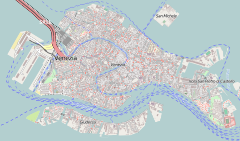Great German Synagogue
 From Wikipedia the free encyclopedia
From Wikipedia the free encyclopedia
| Great German Synagogue | |
|---|---|
 The synagogue building seen from the square of the Ghetto Nuovo | |
| Religion | |
| Affiliation | Orthodox Judaism |
| Status | Inactive |
| Location | |
| Location | |
| Geographic coordinates | 45°26′42.2138″N 12°19′37.6381″E / 45.445059389°N 12.327121694°E |
| Architecture | |
| Completed | 1528 |
The Great German Synagogue (Italian: Scuola Grande Tedesca) is one of five synagogues in the Jewish Ghetto of Venice, Italy. Established in 1528, it is the oldest Venetian synagogue.[1][2]
The synagogue was most recently restored between 2016 and 2017 by the World Monuments Fund.[3] No longer used for regular worship, it is open to the public through the Jewish Museum of Venice.
History[edit]
The Great German Synagogue is one of the three synagogues located in the Ghetto Nuovo (the oldest part of the Venetian Ghetto, established on 29 March 1516),[4] together with the Scuola Canton and Scuola Italiana. It was built in 1528[5][6] by members of the local Ashkenazi community. A stone plaque on the west wall of the building records its construction at the expense of two donors.[7] Like the other four synagogues in Venice, it was termed a scuola ("School"), rather than sinagoga ("Synagogue"), in the same way in which Ashkenazi Jews refer to the synagogue as the shul (שול) in Yiddish.
The Great German Synagogue was the first public synagogue erected in the Ghetto Nuovo. Together with the nearby Scuola Canton, completed in 1532, it stands as a testament to the influence of the Ashkenazi community in the early years of the Ghetto, before the arrival of the much more affluent Jewish merchants from Spain and the Levant in the 1550s.[8]
Along with the other synagogues of Venice, it ceased to be regularly used in October 1917, when the local Jewish community was forced to disband;[a] at the same time, administration of all the Jewish places of worship was taken over by a single institution, the Templi Israelitici Uniti.[10]
Architecture[edit]
Built on top of a preexisting structure, the prayer hall features an irregular shape.[7] The bimah was originally placed in the middle of the room in accordance with the traditional "central bimah" configuration,[11] and only later moved to the north end of the sanctuary.[12]
Gallery[edit]
- The ark
- The bimah
- The women's gallery
- The ark projecting over the rear canal
Notes[edit]
- ^ In the days of the Battle of Caporetto, many Venetian Jews were transferred to Livorno—another Italian city home to an important Jewish community—as a precaution against an Austro-Hungarian invasion.[9]
References[edit]
- ^ Davis & Ravid 2001, p. 43.
- ^ Tigay 1994, p. 542.
- ^ Venice Synagogues Window Restoration. World Monument Fund. Retrieved March 16, 2020.
- ^ Curiel & Cooperman 1990, p. 30.
- ^ Stiefel 2016, pp. 47–48.
- ^ The synagogues. Jewish Museum of Venice. Retrieved July 14, 2016.
- ^ a b Krinsky 1996, p. 379.
- ^ Laskin, David (March 9, 2016). 500 Years of Jewish Life in Venice. The New York Times. Retrieved May 05, 2022.
- ^ Calimani, Sullam Reinisch & Vivante 2000, p. 45.
- ^ Curiel & Cooperman 1990, p. 55.
- ^ Turner 1979, p. 293.
- ^ Concina, Camerino & Calabi 1991, pp. 102, 107.
Cited literature[edit]
- Calimani, Riccardo; Sullam Reinisch, Giovannina; Vivante, Cesare (2000). Venezia: guida alle sinagoghe, al museo e al cimitero (in Italian). Venice: Marsilio. ISBN 8831776304.
- Concina, Ennio; Camerino, Ugo; Calabi, Donatella (1991). La Città degli Ebrei. Il Ghetto di Venezia: Architettura e Urbanistica (in Italian). Venice: Albrizzi Editore. ISBN 8831754890.
- Curiel, Roberta; Cooperman, Bernard Dov (1990). The Ghetto of Venice. London–New York: Tauris Parke. ISBN 1850432368.
- Davis, Robert C.; Ravid, Benjamin, eds. (2001). The Jews of Early Modern Venice. Baltimore–London: Johns Hopkins University Press. ISBN 0-8018-6512-3.
- Krinsky, Carol H. (1996). Synagogues of Europe: Architecture, History, Meaning. Mineola, NY: Dover Publications. ISBN 9780486290782.
- Stiefel, Barry L. (2016). Jews and the Renaissance of Synagogue Architecture, 1450–1730. London–New York: Routledge. ISBN 978-1317320326.
- Tigay, Alan M., ed. (1994). The Jewish Traveler: Hadassah Magazine's Guide to the World's Jewish Communities and Sights. Northvale, N.J.–Jerusalem: Jason Aronson. ISBN 978-1-56821-078-0.
- Turner, Harold W. (1979). From Temple to Meeting House: The Phenomenology and Theology of Places of Worship. The Hague–Paris–New York: Walter de Gruyter. ISBN 1850432368.





